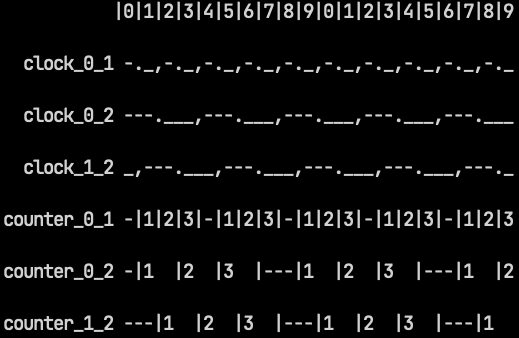Simulation and Testing#
Simulation#
- class pyrtl.simulation.Simulation(tracer=True, register_value_map={}, memory_value_map={}, default_value=0, block=None)[source]#
A class for simulating blocks of logic step by step.
A Simulation step works as follows:
Registers are updated:
(If this is the first step) With the default values passed in to the Simulation during instantiation and/or any reset values specified in the individual registers.
(Otherwise) With their next values calculated in the previous step (
rlogic nets).
The new values of these registers as well as the values of block inputs are propagated through the combinational logic.
Memory writes are performed (
@logic nets).The current values of all wires are recorded in the trace.
The next values for the registers are saved, ready to be applied at the beginning of the next step.
Note that the register values saved in the trace after each simulation step are from before the register has latched in its newly calculated values, since that latching in occurs at the beginning of the next step.
In addition to the functions methods listed below, it is sometimes useful to reach into this class and access internal state directly. Of particular usefulness are:
.tracer: stores theSimulationTracein which results are stored.value: a map from every signal in the block to its current simulation value.regvalue: a map from register to its value on the next tick.memvalue: a map from memid to a dictionary of address: value
- __init__(tracer=True, register_value_map={}, memory_value_map={}, default_value=0, block=None)[source]#
Creates a new circuit simulator.
- Parameters:
tracer (SimulationTrace) – Stores execution results. Defaults to a new
SimulationTracewith no params passed to it. If None is passed, no tracer is instantiated (which is good for long running simulations). If the default (true) is passed, Simulation will create a new tracer automatically which can be referenced by the member variable.tracerregister_value_map (dict[Register, int]) – Defines the initial value for the registers specified; overrides the registers’s
reset_value.memory_value_map – Defines initial values for many addresses in a single or multiple memory. Format: {Memory: {address: Value}}. Memory is a memory block, address is the address of a value
default_value (int) – The value that all unspecified registers and memories will initialize to (default 0). For registers, this is the value that will be used if the particular register doesn’t have a specified
reset_value, and isn’t found in the register_value_map.block (Block) – the hardware block to be traced (which might be of type
PostSynthBlock). Defaults to the working block
Warning: Simulation initializes some things when called with
__init__(), so changing items in the block for Simulation will likely break the simulation.
- inspect(w)[source]#
Get the value of a WireVector in the last simulation cycle.
- Parameters:
w (str) – the name of the WireVector to inspect (passing in a WireVector instead of a name is deprecated)
- Returns:
value of w in the current step of simulation
Will throw KeyError if w does not exist in the simulation.
Example:
sim.inspect('a') == 10 # returns value of wire 'a' at current step
- inspect_mem(mem)[source]#
Get the values in a map during the current simulation cycle.
- Parameters:
mem – the memory to inspect
- Returns:
{address: value}
Note that this returns the current memory state. Modifying the dictonary will also modify the state in the simulator
- step(provided_inputs)[source]#
Take the simulation forward one cycle.
- Parameters:
provided_inputs – a dictionary mapping WireVectors to their values for this step
A step causes the block to be updated as follows, in order:
Registers are updated with their
nextvalues computed in the previous cycleBlock inputs and these new register values propagate through the combinational logic
Memories are updated
The
nextvalues of the registers are saved for use in step 1 of the next cycle.
All input wires must be in the provided_inputs in order for the simulation to accept these values.
Example: if we have inputs named
aandx, we can call:sim.step({'a': 1, 'x': 23})
to simulate a cycle with values 1 and 23 respectively.
- step_multiple(provided_inputs={}, expected_outputs={}, nsteps=None, file=<_io.TextIOWrapper name='<stdout>' mode='w' encoding='utf-8'>, stop_after_first_error=False)[source]#
Take the simulation forward N cycles, based on the number of values for each input
- Parameters:
provided_inputs – a dictionary mapping WireVectors to their values for N steps
expected_outputs – a dictionary mapping WireVectors to their expected values for N steps; use
?to indicate you don’t care what the value at that step isnsteps – number of steps to take (defaults to None, meaning step for each supplied input value)
file – where to write the output (if there are unexpected outputs detected)
stop_after_first_error – a boolean flag indicating whether to stop the simulation after encountering the first error (defaults to False)
All input wires must be in the provided_inputs in order for the simulation to accept these values. Additionally, the length of the array of provided values for each input must be the same.
When nsteps is specified, then it must be less than or equal to the number of values supplied for each input when provided_inputs is non-empty. When provided_inputs is empty (which may be a legitimate case for a design that takes no inputs), then nsteps will be used. When nsteps is not specified, then the simulation will take the number of steps equal to the number of values supplied for each input.
Example: if we have inputs named
aandband outputo, we can call:sim.step_multiple({'a': [0,1], 'b': [23,32]}, {'o': [42, 43]})
to simulate 2 cycles, where in the first cycle
aandbtake on 0 and 23, respectively, andois expected to have the value 42, and in the second cycleaandbtake on 1 and 32, respectively, andois expected to have the value 43.If your values are all single digit, you can also specify them in a single string, e.g.:
sim.step_multiple({'a': '01', 'b': '01'})
will simulate 2 cycles, with
aandbtaking on 0 and 0, respectively, on the first cycle and 1 and 1, respectively, on the second cycle.Example: if the design had no inputs, like so:
a = pyrtl.Register(8) b = pyrtl.Output(8, 'b') a.next <<= a + 1 b <<= a sim = pyrtl.Simulation() sim.step_multiple(nsteps=3)
Using
sim.step_multiple(nsteps=3)simulates 3 cycles, after which we would expect the value ofbto be 2.
Fast (JIT to Python) Simulation#
- class pyrtl.simulation.FastSimulation(register_value_map={}, memory_value_map={}, default_value=0, tracer=True, block=None, code_file=None)[source]#
A class for running JIT-to-python implementations of blocks.
A Simulation step works as follows:
Registers are updated:
(If this is the first step) With the default values passed in to the Simulation during instantiation and/or any reset values specified in the individual registers.
(Otherwise) With their next values calculated in the previous step (
rlogic nets).
The new values of these registers as well as the values of block inputs are propagated through the combinational logic.
Memory writes are performed (
@logic nets).The current values of all wires are recorded in the trace.
The next values for the registers are saved, ready to be applied at the beginning of the next step.
Note that the register values saved in the trace after each simulation step are from before the register has latched in its newly calculated values, since that latching in occurs at the beginning of the next step.
- __init__(register_value_map={}, memory_value_map={}, default_value=0, tracer=True, block=None, code_file=None)[source]#
Instantiates a Fast Simulation instance.
The interface for FastSimulation and Simulation should be almost identical. In addition to the Simulation arguments, FastSimulation additionally takes:
- Parameters:
code_file – The file in which to store a copy of the generated Python code. Defaults to no code being stored.
Look at
Simulation.__init__()for descriptions for the other parameters.This builds the Fast Simulation compiled Python code, so all changes to the circuit after calling this function will not be reflected in the simulation.
- inspect(w)[source]#
Get the value of a WireVector in the last simulation cycle.
- Parameters:
w (str) – the name of the WireVector to inspect (passing in a WireVector instead of a name is deprecated)
- Returns:
value of w in the current step of simulation
Will throw KeyError if w is not being tracked in the simulation.
- inspect_mem(mem)[source]#
Get the values in a map during the current simulation cycle.
- Parameters:
mem – the memory to inspect
- Returns:
{address: value}
Note that this returns the current memory state. Modifying the dictonary will also modify the state in the simulator
- step(provided_inputs)[source]#
Run the simulation for a cycle.
- Parameters:
provided_inputs – a dictionary mapping WireVectors (or their names) to their values for this step (eg: {wire: 3, “wire_name”: 17})
A step causes the block to be updated as follows, in order:
- step_multiple(provided_inputs={}, expected_outputs={}, nsteps=None, file=<_io.TextIOWrapper name='<stdout>' mode='w' encoding='utf-8'>, stop_after_first_error=False)[source]#
- Take the simulation forward N cycles, where N is the number of
values for each provided input.
- Parameters:
provided_inputs – a dictionary mapping WireVectors to their values for N steps
expected_outputs – a dictionary mapping WireVectors to their expected values for N steps; use
?to indicate you don’t care what the value at that step isnsteps – number of steps to take (defaults to None, meaning step for each supplied input value)
file – where to write the output (if there are unexpected outputs detected)
stop_after_first_error – a boolean flag indicating whether to stop the simulation after the step where the first errors are encountered (defaults to False)
All input wires must be in the provided_inputs in order for the simulation to accept these values. Additionally, the length of the array of provided values for each input must be the same.
When nsteps is specified, then it must be less than or equal to the number of values supplied for each input when provided_inputs is non-empty. When provided_inputs is empty (which may be a legitimate case for a design that takes no inputs), then nsteps will be used. When nsteps is not specified, then the simulation will take the number of steps equal to the number of values supplied for each input.
Example: if we have inputs named
aandband outputo, we can call:sim.step_multiple({'a': [0,1], 'b': [23,32]}, {'o': [42, 43]})
to simulate 2 cycles, where in the first cycle
aandbtake on 0 and 23, respectively, andois expected to have the value 42, and in the second cycleaandbtake on 1 and 32, respectively, andois expected to have the value 43.If your values are all single digit, you can also specify them in a single string, e.g.:
sim.step_multiple({'a': '01', 'b': '01'})
will simulate 2 cycles, with
aandbtaking on 0 and 0, respectively, on the first cycle and 1 and 1, respectively, on the second cycle.Example: if the design had no inputs, like so:
a = pyrtl.Register(8) b = pyrtl.Output(8, 'b') a.next <<= a + 1 b <<= a sim = pyrtl.Simulation() sim.step_multiple(nsteps=3)
Using
sim.step_multiple(nsteps=3)simulates 3 cycles, after which we would expect the value ofbto be 2.
Compiled (JIT to C) Simulation#
- class pyrtl.compilesim.CompiledSimulation(tracer=True, register_value_map={}, memory_value_map={}, default_value=0, block=None)[source]#
Simulate a block, compiling to C for efficiency.
This module provides significant speed improvements over
FastSimulation, at the cost of somewhat longer setup time. Generally this will do better thanFastSimulationfor simulations requiring over 1000 steps. It is not built to be a debugging tool, though it may help with debugging. Note that onlyInputandOutputwires can be traced using CompiledSimulation. This code is still experimental, but has been used on designs of significant scale to good effect.In order to use this, you need:
A 64-bit processor
GCC (tested on version 4.8.4)
A 64-bit build of Python
If using the multiplication operand, only some architectures are supported:
x86-64 / amd64
arm64 / aarch64
mips64 (untested)
default_value is currently only implemented for registers, not memories.
A Simulation step works as follows:
Registers are updated:
(If this is the first step) With the default values passed in to the Simulation during instantiation and/or any reset values specified in the individual registers.
(Otherwise) With their next values calculated in the previous step (
rlogic nets).
The new values of these registers as well as the values of block inputs are propagated through the combinational logic.
Memory writes are performed (
@logic nets).The current values of all wires are recorded in the trace.
The next values for the registers are saved, ready to be applied at the beginning of the next step.
Note that the register values saved in the trace after each simulation step are from before the register has latched in its newly calculated values, since that latching in occurs at the beginning of the next step.
- __init__(tracer=True, register_value_map={}, memory_value_map={}, default_value=0, block=None)[source]#
- run(inputs)[source]#
Run many steps of the simulation.
- Parameters:
inputs – A list of input mappings for each step; its length is the number of steps to be executed.
- step(inputs)[source]#
Run one step of the simulation.
- Parameters:
inputs – A mapping from input names to the values for the step.
A step causes the block to be updated as follows, in order:
- step_multiple(provided_inputs={}, expected_outputs={}, nsteps=None, file=<_io.TextIOWrapper name='<stdout>' mode='w' encoding='utf-8'>, stop_after_first_error=False)[source]#
- Take the simulation forward N cycles, where N is the number of values
for each provided input.
- Parameters:
provided_inputs – a dictionary mapping wirevectors to their values for N steps
expected_outputs – a dictionary mapping wirevectors to their expected values for N steps; use
?to indicate you don’t care what the value at that step isnsteps – number of steps to take (defaults to None, meaning step for each supplied input value)
file – where to write the output (if there are unexpected outputs detected)
stop_after_first_error – a boolean flag indicating whether to stop the simulation after the step where the first errors are encountered (defaults to False)
All input wires must be in the provided_inputs in order for the simulation to accept these values. Additionally, the length of the array of provided values for each input must be the same.
When nsteps is specified, then it must be less than or equal to the number of values supplied for each input when provided_inputs is non-empty. When provided_inputs is empty (which may be a legitimate case for a design that takes no inputs), then nsteps will be used. When nsteps is not specified, then the simulation will take the number of steps equal to the number of values supplied for each input.
Example: if we have inputs named
aandband outputo, we can call:sim.step_multiple({'a': [0,1], 'b': [23,32]}, {'o': [42, 43]})
to simulate 2 cycles, where in the first cycle
aandbtake on 0 and 23, respectively, andois expected to have the value 42, and in the second cycleaandbtake on 1 and 32, respectively, andois expected to have the value 43.If your values are all single digit, you can also specify them in a single string, e.g.:
sim.step_multiple({'a': '01', 'b': '01'})
will simulate 2 cycles, with
aandbtaking on 0 and 0, respectively, on the first cycle and 1 and 1, respectively, on the second cycle.Example: if the design had no inputs, like so:
a = pyrtl.Register(8) b = pyrtl.Output(8, 'b') a.next <<= a + 1 b <<= a sim = pyrtl.Simulation() sim.step_multiple(nsteps=3)
Using
sim.step_multiple(nsteps=3)simulates 3 cycles, after which we would expect the value ofbto be 2.
Simulation Trace#
- class pyrtl.simulation.SimulationTrace(wires_to_track=None, block=None)[source]#
Storage and presentation of simulation waveforms.
- __init__(wires_to_track=None, block=None)[source]#
Creates a new Simulation Trace
- Parameters:
wires_to_track – The wires that the tracer should track. If unspecified, will track all explicitly-named wires. If set to
'all', will track all wires, including internal wires.block – Block containing logic to trace
- print_perf_counters(*trace_names, file=<_io.TextIOWrapper name='<stdout>' mode='w' encoding='utf-8'>)[source]#
Print performance counter statistics for trace_names.
- Parameters:
trace_names (str) – List of trace names. Each trace must be a single-bit wire.
file – The place to write output, defaults to stdout.
This function prints the number of cycles where each trace’s value is one. This is useful for counting the number of times important events occur in a simulation, such as cache misses and branch mispredictions.
- print_trace(file=<_io.TextIOWrapper name='<stdout>' mode='w' encoding='utf-8'>, base=10, compact=False)[source]#
Prints a list of wires and their current values.
- Parameters:
base (int) – the base the values are to be printed in
compact (bool) – whether to omit spaces in output lines
- print_vcd(file=<_io.TextIOWrapper name='<stdout>' mode='w' encoding='utf-8'>, include_clock=False)[source]#
Print the trace out as a VCD File for use in other tools.
- Parameters:
file – file to open and output vcd dump to.
include_clock – boolean specifying if the implicit clk should be included.
Dumps the current trace to file as a value change dump file. The file parameter defaults to
stdoutand the include_clock defaults to False.Examples:
sim_trace.print_vcd() sim_trace.print_vcd("my_waveform.vcd", include_clock=True)
- render_trace(trace_list=None, file=<_io.TextIOWrapper name='<stdout>' mode='w' encoding='utf-8'>, renderer=<pyrtl.simulation.WaveRenderer object>, symbol_len=None, repr_func=<built-in function hex>, repr_per_name={}, segment_size=1)[source]#
Render the trace to a file using unicode and ASCII escape sequences.
- Parameters:
trace_list (list[str]) – A list of signal names to be output in the specified order.
file – The place to write output, default to stdout.
renderer (WaveRenderer) – An object that translates traces into output bytes.
symbol_len (int) – The “length” of each rendered value in characters. If None, the length will be automatically set such that the largest represented value fits.
repr_func – Function to use for representing each value in the trace; examples are
hex,oct,bin, andstr(for decimal), or the function returned byenum_name(). Defaults to ‘hex’.repr_per_name – Map from signal name to a function that takes in the signal’s value and returns a user-defined representation. If a signal name is not found in the map, the argument repr_func will be used instead.
segment_size (int) – Traces are broken in the segments of this number of cycles.
The resulting output can be viewed directly on the terminal or looked at with more or less -R which both should handle the ASCII escape sequences used in rendering.
Wave Renderer#
- class pyrtl.simulation.WaveRenderer(constants)[source]#
Render a SimulationTrace to the terminal.
See
examples/renderer-demo.py, which renders traces with various options. You can choose a default renderer by exporting thePYRTL_RENDERERenvironment variable. See the documentation for subclasses ofRendererConstants.
- pyrtl.simulation.enum_name(EnumClass)[source]#
Returns a function that returns the name of an enum value as a string.
Use
enum_nameas arepr_funcorrepr_per_nameforSimulationTrace.render_trace()to display enum names, instead of their numeric value, in traces. Example:class State(enum.IntEnum): FOO = 0 BAR = 1 state = Input(name='state', bitwidth=1) sim = Simulation() sim.step_multiple({'state': [State.FOO, State.BAR]}) # Generates a trace like: # │0 │1 # # state FOO│BAR sim.tracer.render_trace(repr_per_name={'state': enum_name(State)})
- Parameters:
EnumClass (
type) –enumto convert. This is the enum class, likeState, not an enum value, likeState.FOOor1.- Return type:
Callable[[int],str]- Returns:
A function that accepts an enum value, like
State.FOOor1, and returns the value’s name as a string, like'FOO'.
- class pyrtl.simulation.PowerlineRendererConstants[source]#
Bases:
Utf8RendererConstantsPowerline renderer constants. Font must include powerline glyphs.
This render is closest to a traditional logic analyzer. Single-bit WireVectors are rendered as square waveforms, with vertical rising and falling edges. Multi-bit WireVector values are rendered in reverse-video hexagons.
This renderer requires a terminal font that supports Powerline glyphs
Enable this renderer by default by setting the
PYRTL_RENDERERenvironment variable topowerline.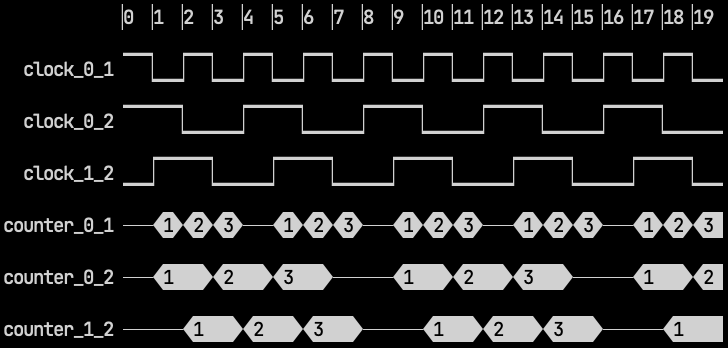
- class pyrtl.simulation.Utf8RendererConstants[source]#
Bases:
RendererConstantsUTF-8 renderer constants. These should work in most terminals.
Single-bit WireVectors are rendered as square waveforms, with vertical rising and falling edges. Multi-bit WireVector values are rendered in reverse-video rectangles.
This is the default renderer on non-Windows platforms.
Enable this renderer by default by setting the
PYRTL_RENDERERenvironment variable toutf-8.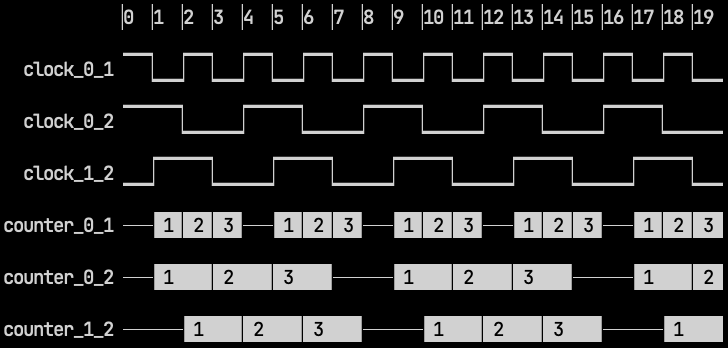
- class pyrtl.simulation.Utf8AltRendererConstants[source]#
Bases:
RendererConstantsAlternative UTF-8 renderer constants.
Single-bit WireVectors are rendered as waveforms with sloped rising and falling edges. Multi-bit WireVector values are rendered in reverse-video rectangles.
Compared to
Utf8RendererConstants, this renderer is more compact because it uses one character between cycles instead of two.Enable this renderer by default by setting the
PYRTL_RENDERERenvironment variable toutf-8-alt.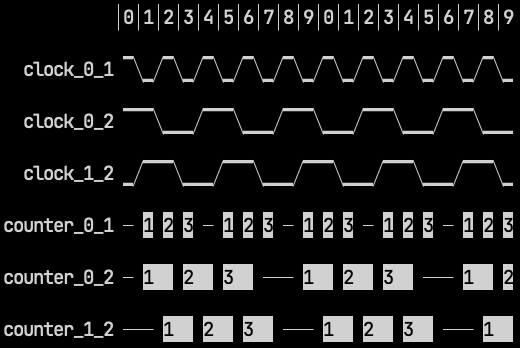
- class pyrtl.simulation.Cp437RendererConstants[source]#
Bases:
RendererConstantsCode page 437 renderer constants (for windows
cmdcompatibility).Single-bit WireVectors are rendered as square waveforms, with vertical rising and falling edges. Multi-bit WireVector values are rendered between vertical bars.
Code page 437 is also known as 8-bit ASCII. This is the default renderer on Windows platforms.
Compared to
Utf8RendererConstants, this renderer is more compact because it uses one character between cycles instead of two, but the wire names are vertically aligned at the bottom of each waveform.Enable this renderer by default by setting the
PYRTL_RENDERERenvironment variable tocp437.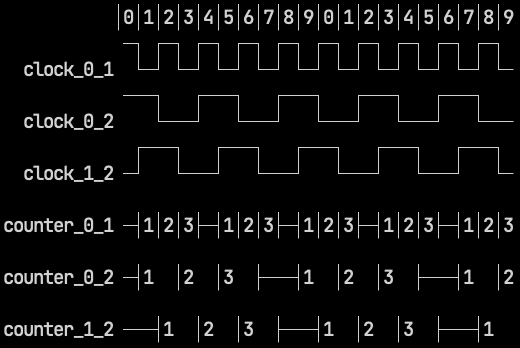
- class pyrtl.simulation.AsciiRendererConstants[source]#
Bases:
RendererConstants7-bit ASCII renderer constants. These should work anywhere.
Single-bit WireVectors are rendered as waveforms with sloped rising and falling edges. Multi-bit WireVector values are rendered between vertical bars.
Enable this renderer by default by setting the
PYRTL_RENDERERenvironment variable toascii.